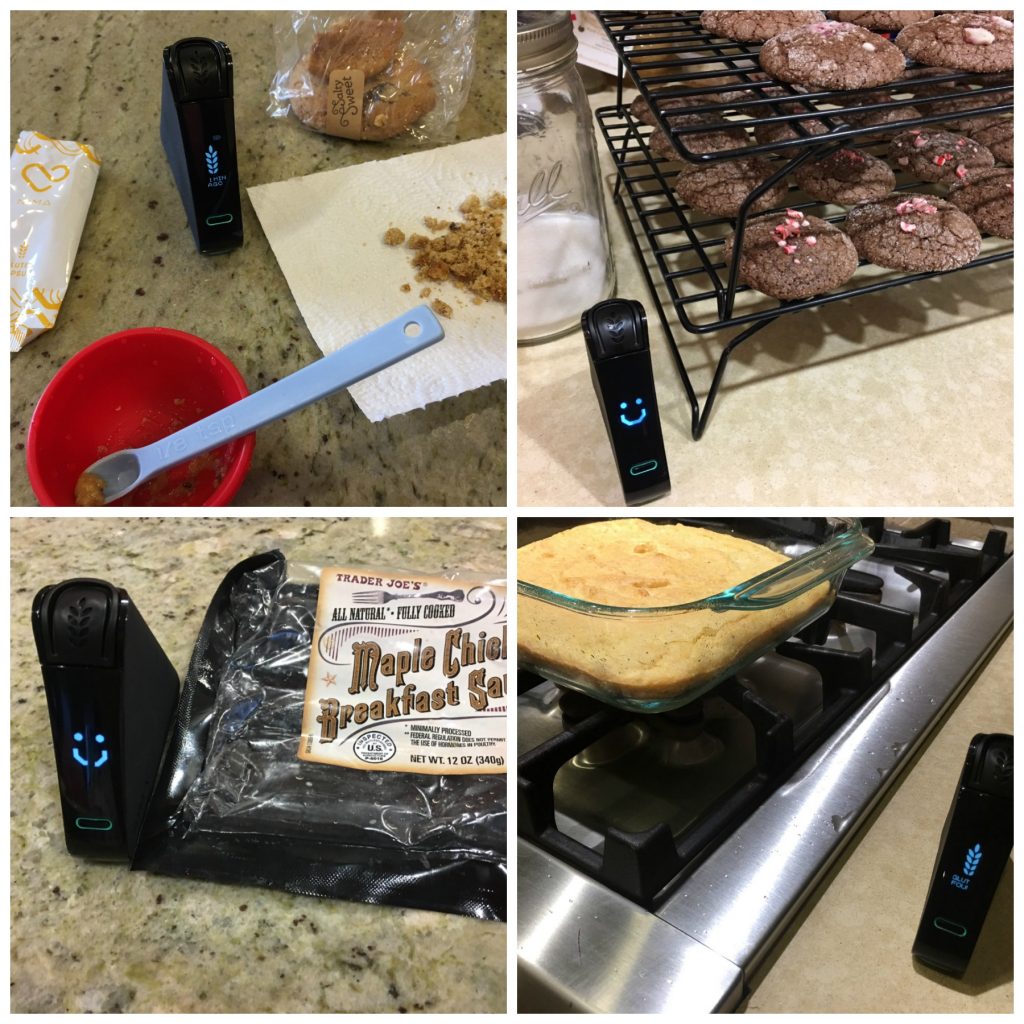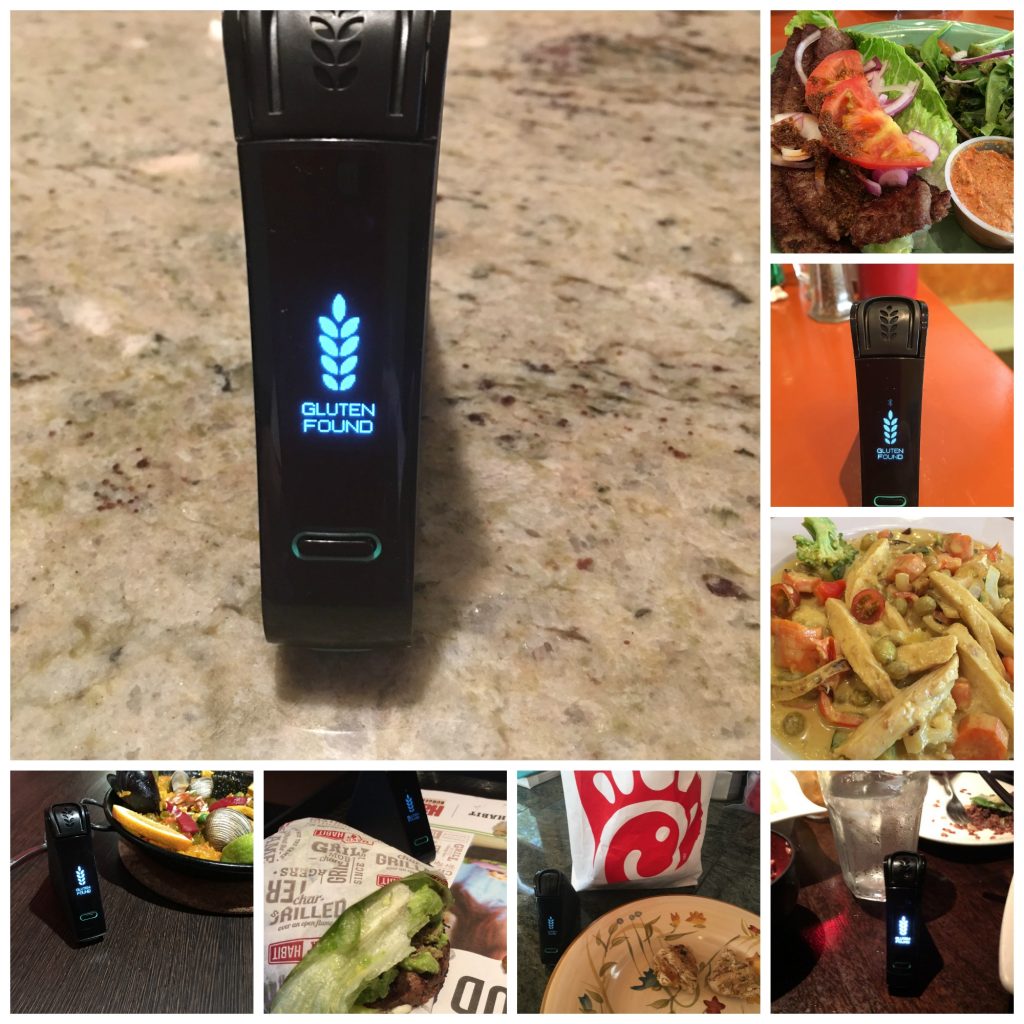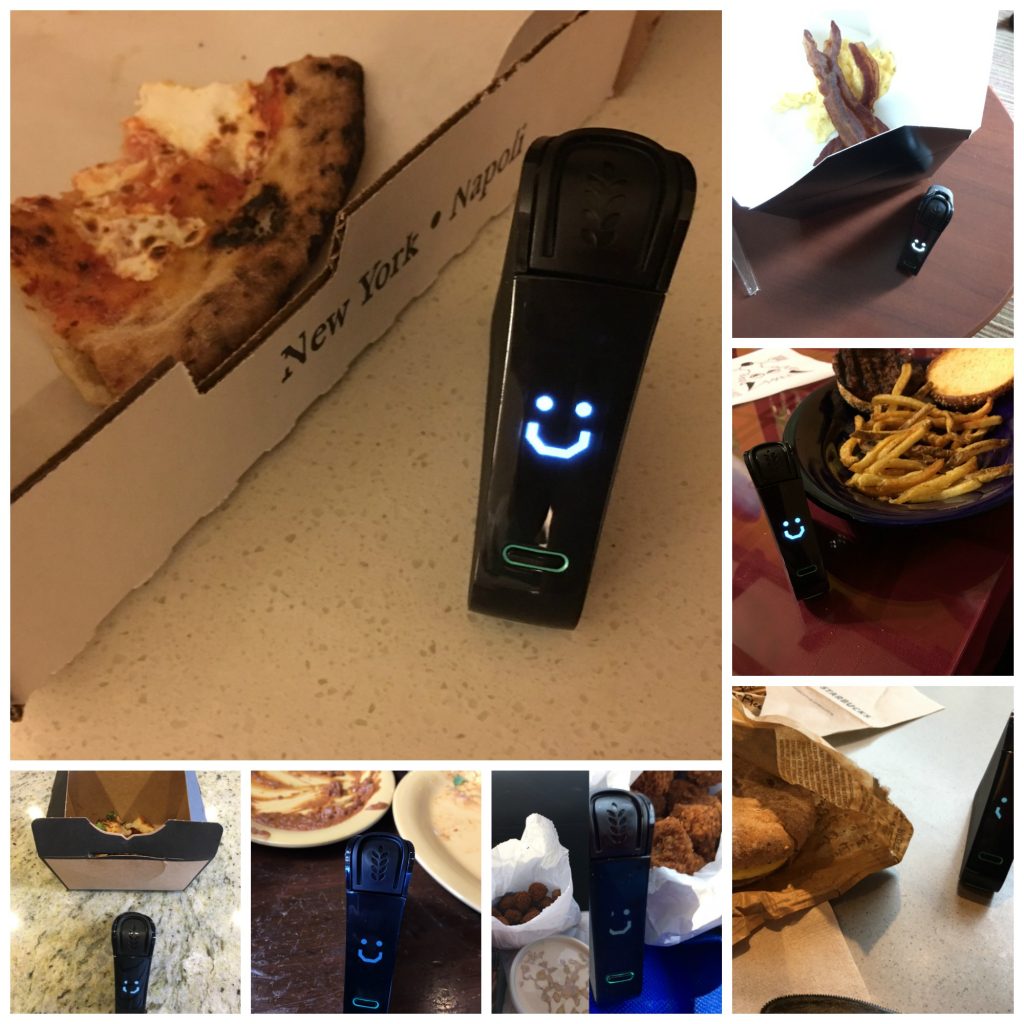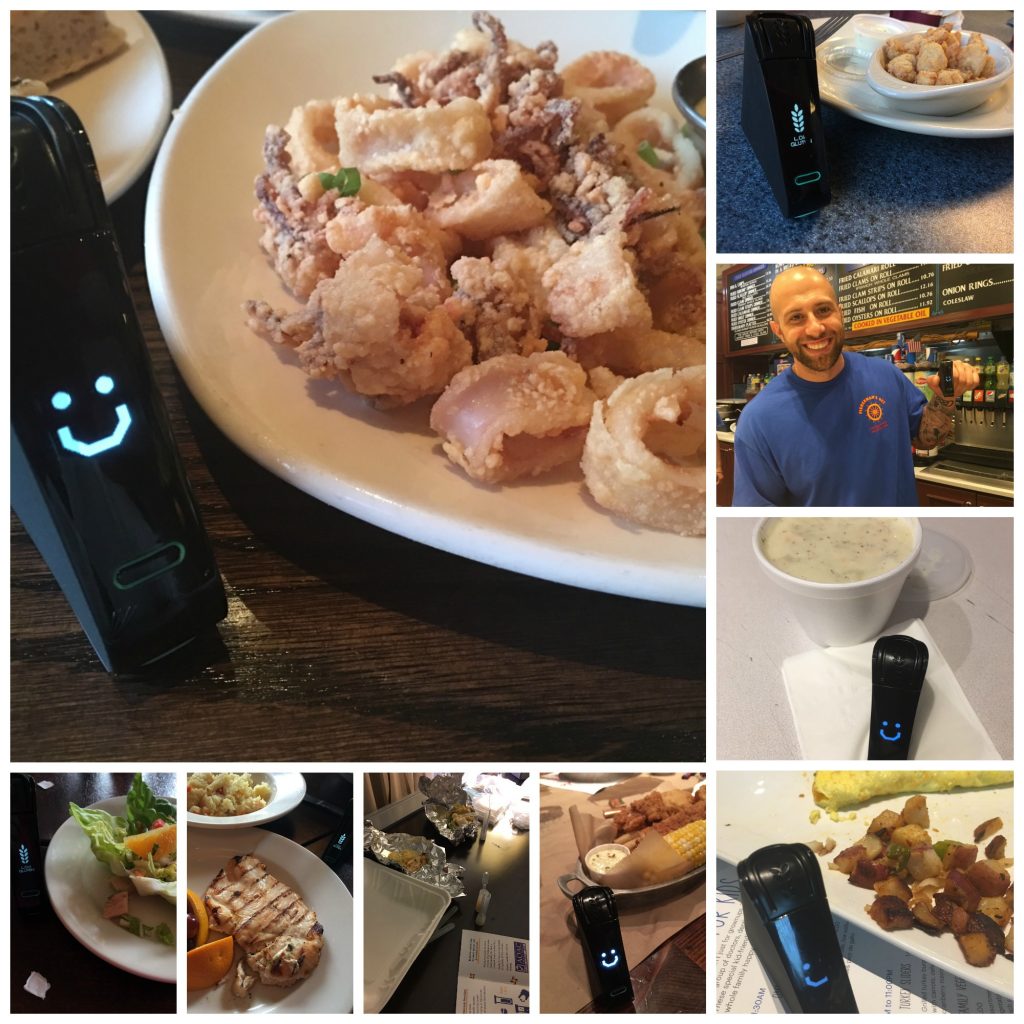
Early days of using my Nima Sensor: suspect cookies reveal gluten found; cookies to be served to celiac group are safe; not labeled gf but felt better knowing these were ok; the cornmeal from a shared facility failed.
People may ask: why use the Nima Sensor? If you have not heard of this little device with its sleek, discreet design, here’s the scoop. The Nima Sensor is a handheld device that can detect gluten in food or liquid (with some exceptions with both) as low as the general standard of 20 parts per million (ppm) and even lower. The cool thing is that currently, although it only tests for gluten, the team who created this handy little device is working on other tests to detect other allergens like nuts and dairy. A capsule for peanuts is to be released by the end of the year. But let’s get back to the why and why it is important to our family.
Thank you to Nima Sensor for providing capsules to me so that I could test food and make an informed decision about the product as well as sponsoring this blog post. The opinions I express are my own and neither the sponsorship nor the provided capsules influenced my thoughts on the device.
Information is powerful.
I’m going to attempt to give you the quick story of why this has been life changing for us. My daughter has been gluten-free since she was almost two years old, about 10 years. She has suffered from eczema for 10 years. She was put on a gluten-free, dairy-free and egg-free diet back then but, thinking it was just a sensitivity, we were never really diligent. Back then, no one ever said “this could be celiac disease”. That’s a whole other conversation. You can read about our story here.
However, each year or two, we made breakthroughs with her skin; it did get better. About 3 or so years ago, after genetic testing and realizing she was a celiac gene carrier, I started getting more strict. But, now I realize I still wasn’t strict enough. So here I am. A mom of a gluten-free kid (technically two gf kids) who thought I was doing a good job. I stopped allowing gluten into the house. I was reading labels. I was asking questions when we went out to eat. It wasn’t enough. Her skin was better but she would occasionally get a flare-up that would take weeks to alleviate. We blamed it on dairy or eggs or the weather. I became friends with a group of moms of celiac kids who told me what they were doing. I still thought to myself “well, we don’t have to be that strict.” Actually, we did.
So the Nima Sensor comes along. I’m at the point of being frustrated because I cannot get my daughter’s skin “fixed”. I decide it’s time to find out if what I think is gluten-free, is actually gluten-free. This, my friends, is where the magic happened for us. In a nutshell, since October 2016, I have found gluten in cornmeal, gluten-free chocolate chip cookies (both purchased in stores), paella, a lettuce-wrapped burger, chicken curry, a gluten-free cupcake, and many more. The latter group were all from restaurants or bakeries. Guess what happened when we stopped eating this suspect food that we thought had been safe? Her skin finally started to heal. We have also found that she can tolerate some dairy and eggs (she was dreading that) but she really can’t tolerate gluten. She’s either undiagnosed celiac or non-celiac gluten sensitive (NCGS) both of which require a huge amount of diligence when it comes to what she eats and what she is exposed to.

Gluten found with the Nima Sensor. This was how I realized my daughter was getting gluten in restaurants. It was about 50% of the time.
As a mom of a kid who has to eat gluten-free, I can tell you, this information has been very powerful. I think I was in denial all of these years. At this point, I don’t care what you call it. My daughter (and son as well) cannot have any gluten at all. They both react (his is a different symptom to hers). They both carry the genes. This is not something to mess around with. Why does it matter? If you want to learn more about celiac disease, the symptoms and risks in being undiagnosed, please read about it here.
How Nima Works
The Nima Sensor is like a little lab in the palm of your hands. Basically, it works like this. You put a pea-sized amount of food into the capsule and twist it shut. This is placed in the sensor and then you turn it on. The test runs for about 2-3 minutes and the result is displayed. A smiley face means no gluten was found. If you see the “gluten found” symbol, the device found some. It might be low but it’s there. To learn more about how the Nima Sensor works, click here. If you want to know how to use it, click here.

Feeling good with Nima! Successes in NYC, our local taqueria, a pizzeria, falafel and the Starbucks GF breakfast sandwich.
Pro Tips
After using it for a number of months, I have a bit of a protocol I follow when I test food:
I wash my hands, and then get clean silverware and a plate in which to get the food ready. This is important especially in a restaurant where gluten could be on the table. If I’m testing anything that might have gluten in one spot but not another, I try to take a little bit of the food from different spots of the food. For example, for pizza, I would test two bits of the crust from different areas, some sauce, cheese and a topping if applicable. Nima has an ever better way. Click here for more info.
The food should be cut into small pieces if possible. The Nima will grind it but once I put a piece of steak in without chopping it and got an error message. If the food is dry, I will add a small amount of water to make a paste. This didn’t work so well with oatmeal but worked better when the oatmeal was cooked.
Again picture a pea. That’s how much food should go into the capsule. Some times it’s a mish-mash of food that I use. Screw it to the right and keep turning until the green ring is no longer exposed and the top is lined up (this will be obvious). Occasionally I had to give it some extra elbow grease to get it to twist in place.
Make sure to keep the sensor upright. Stay nearby in case there’s either an issue or in case the test finishes sooner than you expect. If it finishes and you missed the reading, press the button once to turn it on, then double click to bring back the most recent result.
What it does, how much to use, what to expect
My Experience: For some pics of when and where I used it, check my posts on Instagram and follow me @amythefamilychef.

Mostly everything we tested in Boston was GF; with one restaurant we tested the food afterwards with EZ Gluten strips and got the same results. Legal Seafoods was a winner!
I would say it is not realistic for us to test everything we eat. Instead, we have been more careful with what comes into the house and where we eat out. I tested food that I wasn’t sure of (foods not made in a dedicated facility or not labeled gluten-free) and at restaurants where I just wanted to be sure. One fast casual restaurant we went to, I spent quite awhile speaking to a manager about about what would be needed to make the meal gluten-free. She seemed to understand the requirement, the ticket was written up with “gluten allergy”, and she made the meal. Note: we went at a time when this restaurant was not busy; I would not expect someone to do this during a rush. I thought, well let’s test it. Much to our disappointment, the lettuce-wrapped burger had gluten. That burger was returned and a lesson was learned. Not every restaurant understands the requirements.
I had some cornmeal that I assumed was safe. Sure, the label read “made in a facility that also processes wheat.” Does that label really matter, I thought? Well, yes it does. I made the cornbread and tested it after. Gluten found. Goodbye cornbread and cornmeal. I made another batch with dedicated gf cornmeal and the same ingredients. No problem.
We wanted to go out to dinner for something different so we chose Spanish; seemed pretty safe. I called the restaurant and asked about gluten-free. “Yes, we have gluten-free” the person said who answered the phone. We sat down. Again, not very busy which is usually good. I asked again “which dishes are gluten-free” and we ordered what seemed to be safe items like an egg and potato dish, soup, salad, and paella. I thought I should probably test something so decided upon the paella. Much to my dismay, even though this dish had rice, seafood, broth (that could be suspect), a sauce, and veggies, something in there had gluten. The problem is my daughter had already eaten two of the dishes (not the paella); she reacted the next day. Argh!
I was sent a box of produce and goods to try out. One of the items was gluten-free cookies. We all ate them. The next day, both of my kids reacted. I then looked more closely at the label and it said “Not made in a dedicated gluten-free facility.” Woops. I had missed that. I tested it and yes, you guessed it, Gluten Found (see photo above). My bad for not noticing. However, after contacting the company and making them aware of this, maybe I actually saved someone else from getting sick. Information is powerful!
We were eating at a restaurant in Boone, NC. I found a restaurant that had gotten high praise for its care in gluten-free preparation on my Find Me Gluten-Free app. We tested the bun, burger and the fries. Smiley face! No gluten (see photo above).
I have many of these stories. In my experience, we have found gluten in about 40%-50% of restaurants in Northern California. My hope is that the Nima Sensor will be able to help those chefs to understand what needs to be done. I also wrote a blog post for chefs to give them resources about how to serve a safe gluten-free meal. You can find that here.
How It Changed Our Perspective
Using a Nima is a way to help you make a decision about whether or not YOU feel comfortable eating a food. I can’t decide that for you; nor can Nima. What I like about it is that it has changed my perspective. It has taught me to not make assumptions. It has saved us from gluten exposures; for that I am most thankful. It has helped me to uncover an exposure, making me feel a bit less frustrated. It has brought together bloggers, advocates, friends, and chefs.
My hope is that you will find the Nima as useful as we have. If you are interested in buying one or getting more information, visit this page.
If you have used the Nima or have any questions, please leave a comment below.


[…] New Zealand that the food I served my daughter was safe. I wrote an article about our experience with Nima here if you want to read […]